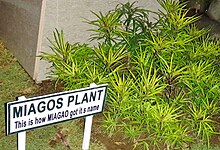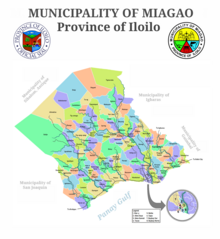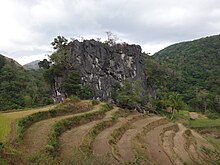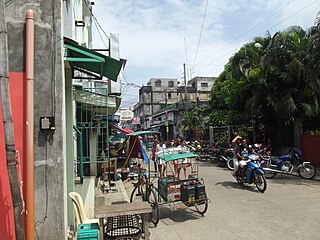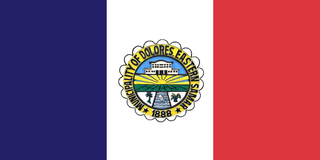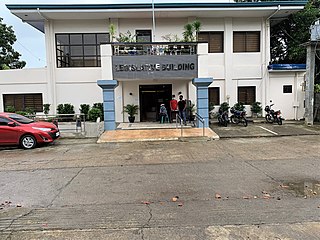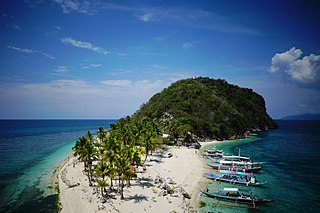Miagao | |
|---|---|
| Municipality of Miagao | |
 Miagao Church | |
| Nickname: "Onion Capital of the Visayas" | |
 Map of Iloilo with Miagao highlighted | |
Location within the Philippines | |
| Coordinates: 10°38′39″N122°14′07″E / 10.6442°N 122.2352°E | |
| Country | Philippines |
| Region | Western Visayas |
| Province | Iloilo |
| District | 1st district |
| Barangays | 119 (see Barangays) |
| Government | |
| • Type | Sangguniang Bayan |
| • Mayor | Oscar "Richard" S. Garin Jr. |
| • Vice Mayor | Macario M. Napulan, MD |
| • Representative | Janette L. Garin |
| • Municipal Council | Members |
| • Electorate | 41,603 voters (2022) |
| Area | |
| • Total | 156.80 km2 (60.54 sq mi) |
| Elevation | 29 m (95 ft) |
| Highest elevation | 1,100 m (3,600 ft) |
| Lowest elevation | 0 m (0 ft) |
| Population (2020 census) [3] | |
| • Total | 68,115 |
| • Density | 430/km2 (1,100/sq mi) |
| • Households | 16,006 |
| Economy | |
| • Income class | 1st municipal income class |
| • Poverty incidence | 17.43 |
| • Revenue | ₱ 218.5 million (2020) |
| • Assets | ₱ 693 million (2020) |
| • Expenditure | ₱ 165.1 million (2020) |
| • Liabilities | ₱ 191.2 million (2020) |
| Service provider | |
| • Electricity | Iloilo 1 Electric Cooperative (ILECO 1) |
| Time zone | UTC+8 (PST) |
| ZIP code | 5023 |
| PSGC | |
| IDD : area code | +63 (0)33 |
| Native languages | Karay-a Hiligaynon Tagalog |
| Website | www |
Miagao (also written Miag-ao), officially the Municipality of Miagao (Kinaray-a : Banwa kang Miagao; Hiligaynon : Banwa sang Miagao; Tagalog : Bayan ng Miagao), is a 1st class municipality in the province of Iloilo, Philippines. According to the 2020 census, it has a population of 68,115 people. [3]
Contents
- Etymology
- History
- Geography
- Topography
- Climate
- Barangays
- Demographics
- Healthcare
- Economy
- Agriculture
- Banks
- Infrastructure
- Public Transport
- Government
- Elected officials
- Highlights
- Miag-ao Church
- Education
- Elementary education
- Secondary education
- Colleges and Universities
- Media
- See also
- References
- External links
Miagao is considered as the "Onion Capital of the Visayas". The town center of the municipality lies on the western bank of the Tumagbok River, the largest river in the municipality. [5] The poblacion is made up of eight barangays. [6]
The town holds their patronal fiesta in honor of St. Thomas of Villanova (more commonly known as Santo Tomas de Villanueva) every September 22 that lasts several days. The town is also the location of one of the Baroque Churches of the Philippines, the Miagao Church, which was inscribed as a UNESCO World Heritage Site. The entire town of Miagao was later inscribed as a UNESCO World Heritage City and became a member of the Organization of World Heritage Cities (OWHC).




